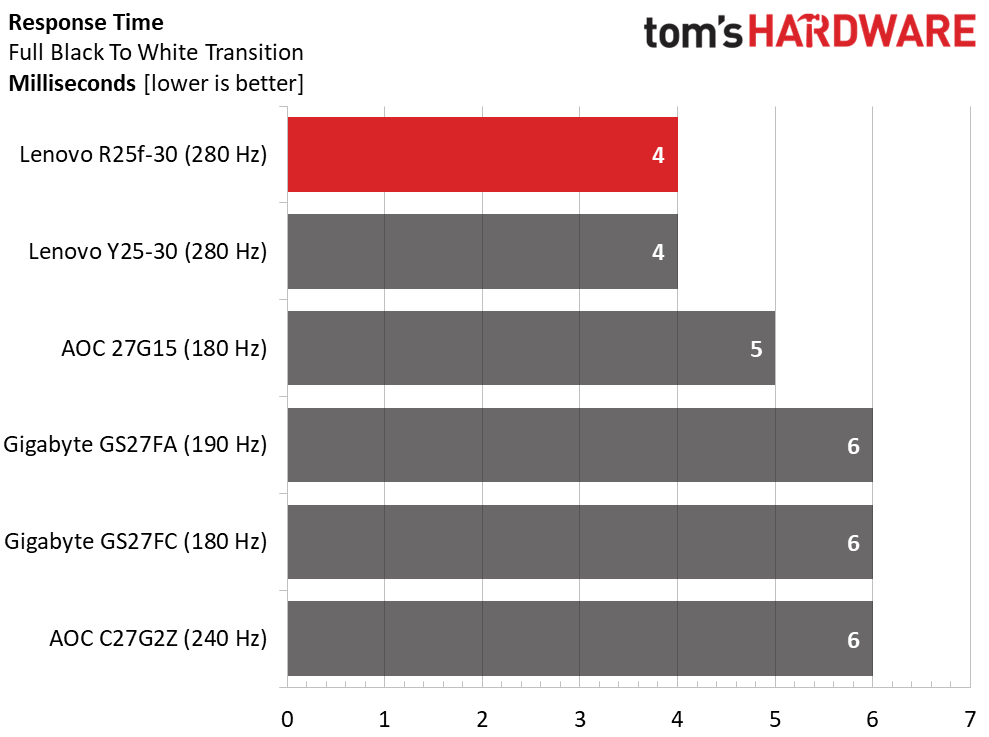Why you can trust Tom's Hardware
To compare the R25f-30’s performance, I’ve created a group of FHD monitors all close in price. Lenovo’s IPS version of this monitor, the Y25-30 is here along with AOC’s 27G15 and C27G2Z, Gigabyte’s GS27FA and GS27FC. Interestingly, I didn’t find many 25-inch screens; they were all 27, except for the other Lenovo. The latest speedy 25-inch monitors are focused on higher refresh rates, 360, 500, and 540 Hz, and therefore cost quite a bit more.
Pixel Response and Input Lag
Click here to read up on our pixel response and input lag testing procedures.


The two Lenovos dominate these tests with their 280 Hz refresh rates. On a dollar/speed basis, they are the best values available. You just need to pick your preferred screen tech, VA or IPS. In the lag test, the R25f-30 wins the day with a very quick 18ms total score. That’s on par with many costlier monitors that run at higher refresh rates. The R25f-30 is further enhanced by its precise overdrive that removes nearly all traces of motion blur.
Test Takeaway: The R25f-30 and Y25-30 are two of the quickest monitors you can buy for less than $200. They both have excellent overdrive, high motion resolution and extremely low input lag. For competition, you’ll need to spend significantly more money to beat them. Realistically, the only way you’ll achieve a better gaming feel is with an OLED.
Viewing Angles

Viewing angles are not VA’s strong suit, but the R25f-30 acquits itself well, especially considering its low price. The side view stays bright with no visible light loss and shifts slightly to red and green. Gamma becomes lighter, which slightly washes out the picture. The top view is almost entirely void of detail, with a 40% light reduction and a red tint.
Screen Uniformity
To learn how we measure screen uniformity, click here.

A slight hotspot in my R25f-30’s upper left corner spoiled the uniformity test result. I could see a bit of glow in a full black pattern with the room lights turned off. It wasn’t a factor in content unless the entire picture was near-black. This is a sample-specific issue.
Get Tom's Hardware's best news and in-depth reviews, straight to your inbox.
MORE: Best Gaming Monitors
MORE: How We Test PC Monitors
MORE: How to Buy a PC Monitor
MORE: How to Choose the Best HDR Monitor
Current page: Response, Input Lag, Viewing Angles and Uniformity
Prev Page Features and Specifications Next Page Brightness and Contrast
Christian Eberle is a Contributing Editor for Tom's Hardware US. He's a veteran reviewer of A/V equipment, specializing in monitors. Christian began his obsession with tech when he built his first PC in 1991, a 286 running DOS 3.0 at a blazing 12MHz. In 2006, he undertook training from the Imaging Science Foundation in video calibration and testing and thus started a passion for precise imaging that persists to this day. He is also a professional musician with a degree from the New England Conservatory as a classical bassoonist which he used to good effect as a performer with the West Point Army Band from 1987 to 2013. He enjoys watching movies and listening to high-end audio in his custom-built home theater and can be seen riding trails near his home on a race-ready ICE VTX recumbent trike. Christian enjoys the endless summer in Florida where he lives with his wife and Chihuahua and plays with orchestras around the state.
